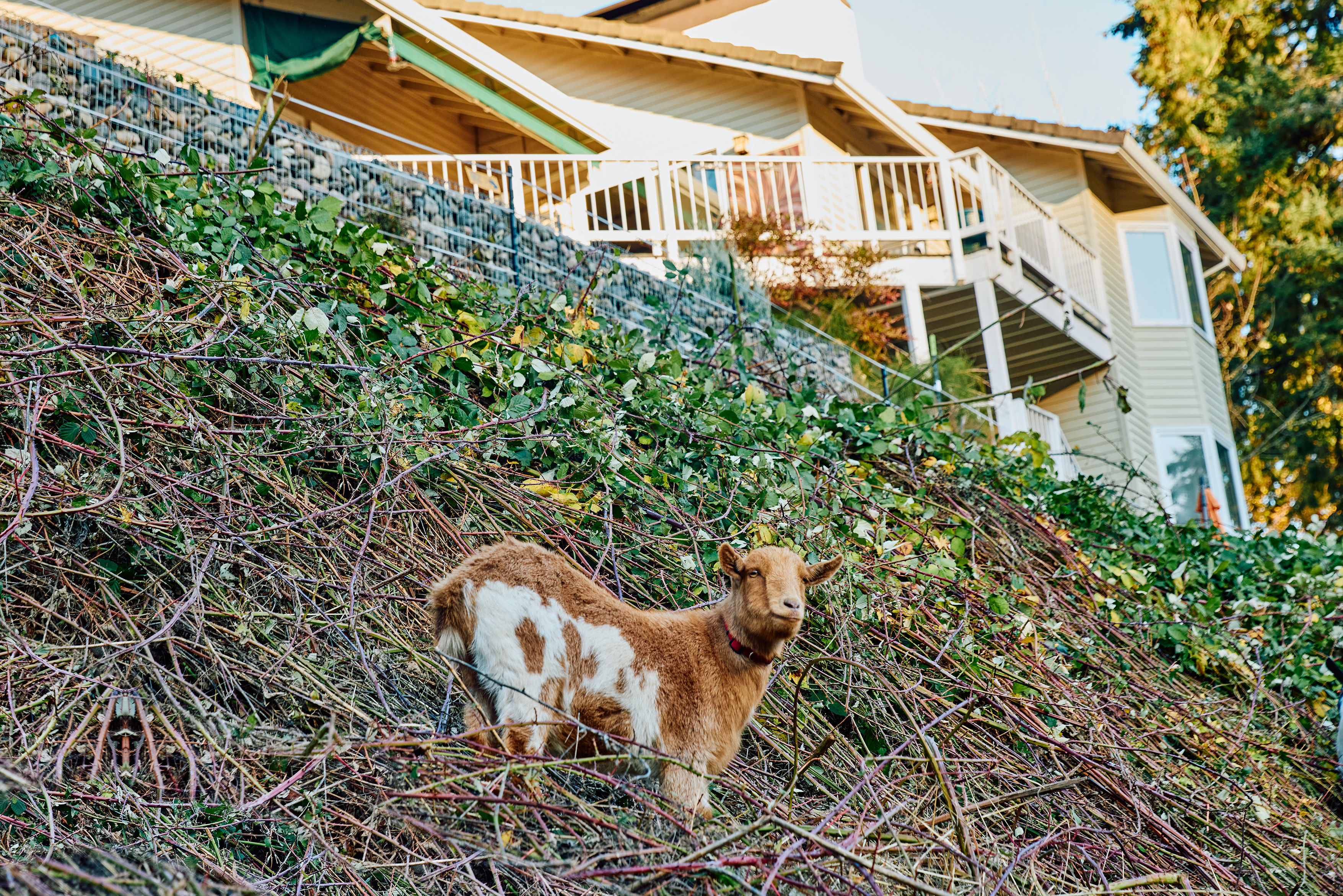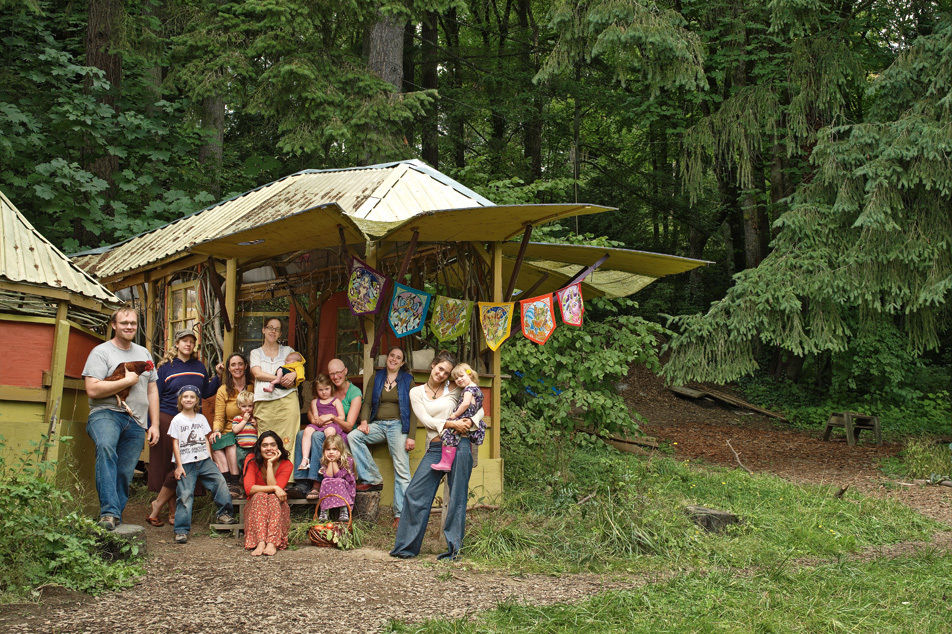
Green Acres
BRENNA BELL’S LEFT FOOT is harshing my bohemian dream. From about the middle of her left shin to the battered top of her sun hat, she’s the epitome of the 21st-century Earth Mama: tank top, cutoff corduroys, tattoo of the lunar cycle orbiting her right biceps, child at the hip. Her walking stick, with a foggy crystal embedded in the top, has red and yellow ribbons streaming from the handle.
She is, quite unapologetically, a hippie. And not the kind maxing out Mom and Dad’s American Express down on Hawthorne, either. “That word has so many meanings,” the 33-year-old says, popping a freshly picked sprig of dill into her mouth. “But if you mean somebody who’s a free-minded person who lives closely with nature and with other people? That’s what I am.”
But then there’s that foot. While the right one is bare and crusted in a funky shell of sweat and dirt from traversing the trails of her communal home here on the outskirts of Tryon Creek State Park in Southwest Portland, the other is packed inside a hospital-issued, plastic-and-metal walking boot. Limping her way through a garden path choked with bamboo shoots, fennel leaves, snap peas, and various other ready-to-eat flora, Bell rehashes the night three months ago when she wiped out on her bike while speeding down the twisty road toward home. It was dark, and she remembers taking the curve a little too fast, losing control, and hitting the ground. When she hoisted herself up on her elbows, she stared blankly at a foot wrenched 90 degrees in the wrong direction.
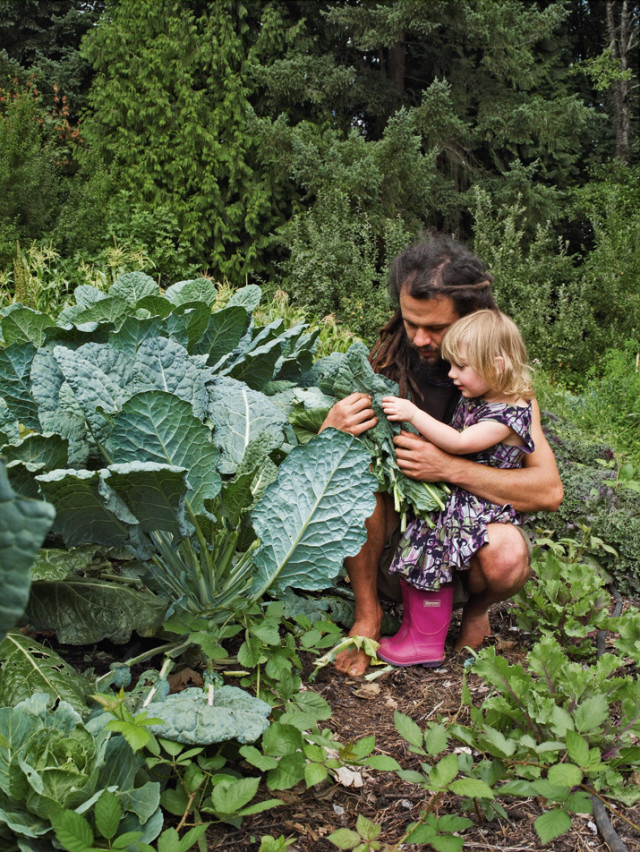
FULL BOUNTY In preparation for the evening’s group dinner, Bonsai Matt and fellow Cedar Moon resident 3-year-old Myrtle pick an armful of giant, leafy kale form their seven-acre farm.
Image: Stuart Mullenberg,Bettie Newell
So it’s with a smile that she informs me that after being confined mostly indoors for the better part of the last 90 days with a dislocated ankle, she’s officially returning to the fold here at the Cedar Moon commune this afternoon. Not just to the fields—where, like everybody else, she must devote at least 15 hours a week to sowing, seeding, weeding, or other tasks related to education and upkeep—but to the surrounding cedars and firs, where she tends to lose herself for hours teaching her 4-year-old daughter, Ember, the names of the trees and flowers.
Recovery, she insists, would’ve been nearly impossible without the help of the other 15 adults (and 6 children) who call Cedar Moon home. While Bell was laid up, they watched her daughter, cooked, changed her pee bucket, and when the pain medication became too much for her stomach, they even scrubbed the puke out of her bedsheets. “Honestly,” she says, “I can’t understand how people don’t live in a commune.”
As we emerge from the man-made archway of blackberry bramble that signals the end of the Edible Forest Garden, where wine cap mushrooms and fern fronds grow wild, the true beauty of Bell’s home reveals itself in a wide, gently sloping hill that encompasses the bulk of Tryon Life Community Farm (TLC Farm), the five-acre garden maintained by Cedar Moon. Lettuce heads, squash, carrot tops, spindly quinoa towers, cornstalks, and just about any other vegetable or fruit you can think of pop up from the ground as far as a shaded eye can squint. Unseen goats bleat. Chickens cluck. Children with names like Talon and Myrtle laugh just within earshot.
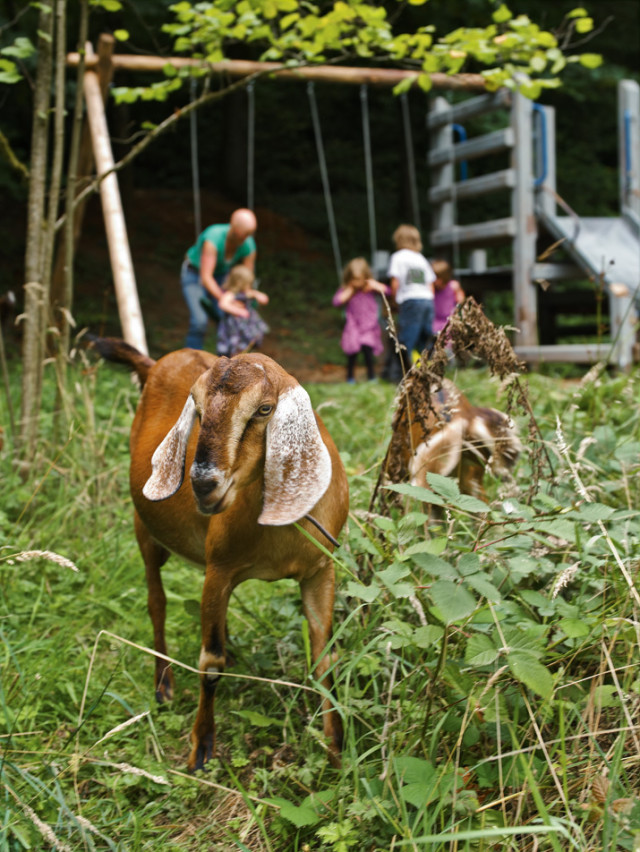
MOTOR MOUTH One of Cedar Moon’s three Nubian goats does its part to help cut back blackberry brambles and other invasive weeds while satisfying its insatiable appetite.
Image: Stuart Mullenberg
It’s a beautiful, ramshackle Eden tucked like a secret into the shade of the city limits. The itch to rip off my shoes and sprint bare-butt through the field begins to spread like a rash.
Sprawling across seven acres along the northwestern edge of Tryon Creek State Park, Cedar Moon exists as a sort of anachronism—something out of M. Night Shyamalan’s The Village. Approach the compound by foot—a mile and a half through a thick forest where trails splinter and direction is easily fumbled—and you feel as though you’ve stumbled onto a lost colony. The only real signpost is a gnarled cedar branch that looks like an elephant’s trunk. There, take a hard right onto a lightly trampled path, and when you see the skeletal remnants of “Robert the Native American’s” sweat lodge, you’ll know you’ve reached the commune.
Of course, if you lack a sense of adventure, it’s probably quicker just to drive.
Southwest Boones Ferry Road runs right past the farm’s well-hidden gravel driveway. In fact, from Bell’s front door, you could lob a hand-harvested cucumber at the stream of minivans speeding home to Lake Oswego. From a sensory standpoint, the constant sound of revving engines kind of ruins the earthy solitude, but it underlines the whole point of this socio-environmental petri dish: Sure, it might be easier to disappear off the grid, into the backwoods, and extend a middle finger to society at large, but as far as effecting real change and offering solutions to ecological concerns, visibility—and, more important, approachability—is vital to Cedar Moon’s mission.
“Accessibility is very important to us,” says 32-year-old Kelly Hogan, a nose-ringed mother of two, as she doles out cupfuls of blueberries to a group of children. “It’s great to get people out here and engage them in activities so they can see that we’re just human beings who are really working hard toward a goal: honoring the earth, living as sustainably as possible, and being true to ourselves.”
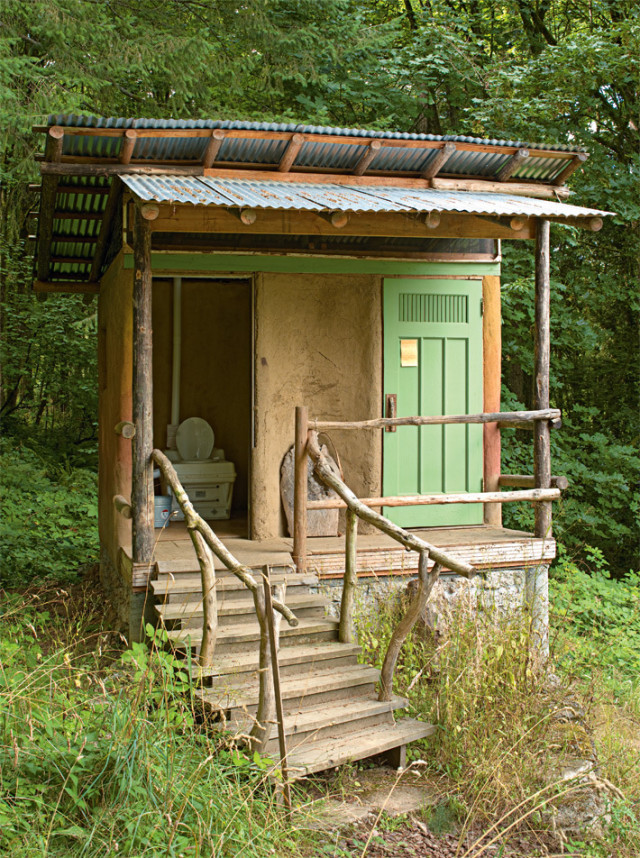
RULE NO. 2 Everything at Cedar Moon is recycled, even human waste, which is collected in this composting toilet for later use as fertilizer in the garden.
Image: Stuart Mullenberg
Considering today’s circumstances, it’s not a bad example to have in our midst. Because as rising gas prices and near-biblical shifts in weather patterns have, thankfully, pushed environmentalism from the realm of the kook into the mainstream, “going green”—even in Portland—has begun to reach the point of cultural saturation. Sure, you can have a 4,000-square-foot home—as long as you have the energy-efficient dishwasher and use compact fluorescent lightbulbs. Or so goes the green marketing message. But buying a hybrid car isn’t exactly going to stop the polar ice caps from melting.
“Sustainability in Portland often seems limited to high-tech green technology,” says Bell, who, at five years, has one of the longest tenures among commune residents. “But with the farm, we’re able to live in a way that has a direct impact on the city. We’re building a new culture here, which is what we need to do to change the world.”
That’s why the community’s fishbowl ethos is dedicated to longer-term solutions. Hogan would argue that things like recyclable structures, a garden-to-table diet, and, yes, reusable poo are the most effective and permanent solutions to our global crisis. And whether you reach Cedar Moon by foot or by car, its residents are more than happy to show you how you, too, can save the world.
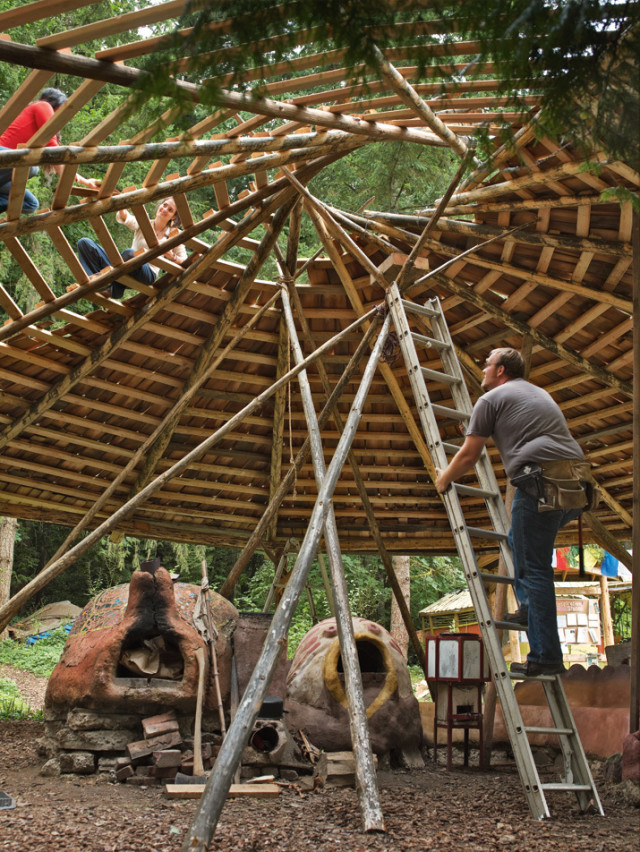
RUSTIC COOKING Cedar Moon’s outdoor stoves and oven are made of a combination of mud and straw called cob. The kitchen’s recently finished roof protects the natural appliances from the rain.
Image: Stuart Mullenberg
Cedar Moon’s story began in 2004. Until then, property that now makes up TLC Farm had been managed by various families since the 1930s. The most recent owners, however, had little interest in working the land, so they rented the parcel to a group of earth-loving farmers who’d taken to calling themselves Cedar Moon. When a developer looking for a place to build a new group of luxury homes offered the owner a large sum of money for the land, the tenants balked. After a two-year battle with the landlord—and after coming up with $750,000 in donations and taking on another $700,000 in loans—the farmers of Cedar Moon snatched the land from the jaws of the bulldozers. They turned the farm into a nonprofit, and the Cedar Moon community became its official caretaker.
“When we were at our eviction hearings, our landlord’s attorney said we were a ‘bunch of delusional optimists,’” Bell recalls. “We actually sort of latched onto that phrase. Delusional optimists change the world. Realistic pessimists? They don’t get much done.”
Now, instead of a small fiefdom of McMansions, Cedar Moon is a living, breathing example of sustainability in action. Not counting the large tepee (the part-time home of resident Bernhard Bach) and the pitched tents of summer interns dotting the edges of the property, the living quarters are confined to two large houses that form the geographical, social, and spiritual center of Cedar Moon. The main abode is a 2,000-square-foot, three-story wooden home whose defining trait is a large communal dining room where bay windows give a widescreen view of the property. Inside, shelves are lined with bulk ingredients in plastic bins, and a dry-erase board lays out the kitchen duties. (Everyone is required to either cook or clean once a week.) In the other house, four private apartment residences are usually inhabited by families or more senior members of the community.
At the southern end of the property, a large barn badly in need of some structural love (sunlight and rain pour through in equal measure) is stuffed with all sorts of farming equipment and row upon row of bicycles, while three Nubian goats munch on blackberry leaves around the perimeter. Their milk and manure are obviously useful, but it’s the goats’ willingness to beat back the creeping vines with their indomitable mouths that makes them truly indispensable. Down a small hill, about 40 chickens peck and scratch at the ground. Their eggs are a daily staple, their flesh a “sometimes food,” and when the flock has razed a plot of grass down to the soil, the henhouse on wheels is moved to another piece of sod. The old ground, now rich with chicken manure, is ready for planting.
Back toward the north end of Cedar Moon is another social hub: an outdoor kitchen equipped with rocket stoves and heated benches, a gazebolike structure called the T-Whale, a raised stage for yoga and outdoor performances, and a sauna. All these things are constructed from cob, an inexpensive mixture of mud and straw, or other biodegradable materials. If left in the rain long enough, everything will melt back into the earth from where it came.
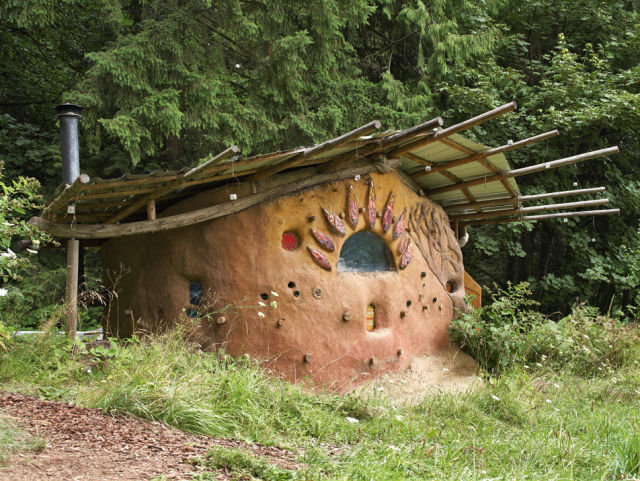
SPA FRODO It might look like something from Middle Earth, but this cob building is actually a sauna, one of the more popular social venues on the property.
Image: Stuart Mullenberg
Placed conveniently next to each major structure on the property is a postcard-size piece of laminated paper that explains the function of the building. The markers are even numbered to help guide the random foot traffic that sometimes wanders into the encampment from the Tryon Creek trails. Most of the time it’s just a curious hiker or a small tour group that wants to see the wild, woolly hippies up close. Of course, there are those awkward times when an interloper arrives wide-eyed and out of breath.
“Every once in a while somebody runs in all panicked, thinking a kid’s in distress,” Bell says, explaining that the bleat of Nubian goats sounds uncannily like a screaming child.
While the goat milking, egg collecting, and food growing is strong evidence of Cedar Moon’s devotion to self-reliance, the commune’s not quite off the grid. Not yet, anyway. Orange extension cords hang in the trees, stretching from a roadside power pole to the houses, and the majority of the water is still doled out by the city. But that’s changing. The electrical fence that keeps the chickens safe from coyotes runs on solar power; warmth in the winter is provided only by fire and oil-fueled heaters; and members of Cedar Moon have spearheaded a movement in Portland to legalize “gray water”—nonsewage wastewater like runoff from showers and sinks—for reuse in agriculture.
And then there’s the composting toilet. Depending on your comfort level with the human body’s basest function, it’s either a truly innovative approach to recycling or the grossest thing this side of a state fair Port-o-Let on free chili dog night. From the outside, the twin side-by-side outhouses look a bit like a cottage—something Julie Andrews and the von Trapps might sing about while holding hands and tra-la-la-ing through the Alps.
Inside the shoulder-width, coffinlike space is a commode, lit only by a small window, that employs two trap doors, a heaping cupful of peat, and—most horrifying of all—no flusher.
“In Portland, people poop in some of the best drinking water in the world,” Bell says, gleefully informing me that a former intern recently finished a master’s thesis on reusing feces. “A lot of people use fossil-fuel fertilizer in their yard but flush their poop away—that’s crazy. We’re taking something that is a waste product and turning it into fantastic fertilizer.”
It’s nice to know that what lies beneath this particular circle of brown-tinted hell will one day help feed a young tomato plant. But as I stare into the eye of the composting toilet—choking back the bile—my heart longs for the reassuring ker-shoosh of a solid, one-gallon flush.
"Anybody know whose giant SUV that is?” Matt Gordon is nearly screaming. This is cause for concern. Usually, Gordon’s clear blue eyes are the epitome of Wooderson cool, regardless of the situation. This is the guy who actually volunteered to act as a guide for the students and campers who tour the grounds on a near-daily basis during the summer, who’s used to equipping preteens with shovels while managing to avoid a revolt, who handles the poo jokes and hippie asides without strangling anybody.
But right now, Gordon is frazzled. The Range Rover in question is keeping a bus full of hormonal junior high kids from turning into the commune’s driveway, and as a result, traffic is backing up on a blind curve on Boones Ferry.
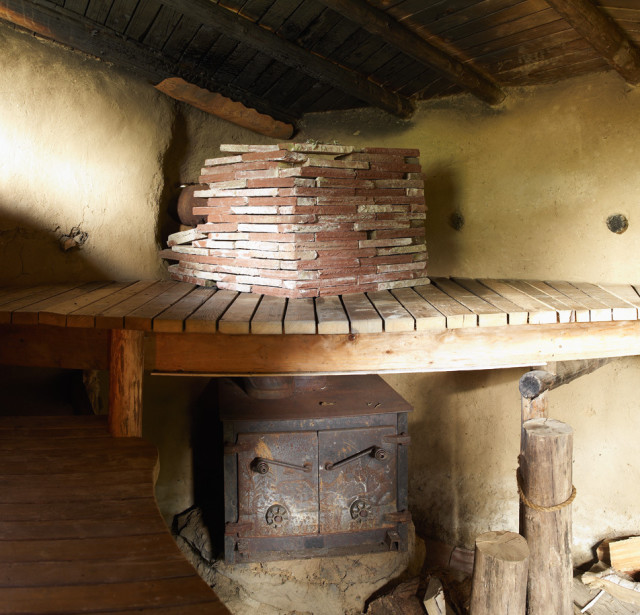
HOT ROCKS Inside the earthen structure, a wood-burning stove heats bricks; mud-and-straw walls keep the temperature at a steady, sweat-inducing level.
Image: Stuart Mullenberg
Soon enough, though, the culprit is found; a mother who is picking up her daughter from Cedar Moon’s on-premises summer camp jogs up the driveway to move her car. Gordon’s eyes return to their guileless state. “I don’t usually get frustrated with that type of stuff,” he says. “It’s part of living here, part of my job, and to be honest, we just like showing the place off.” Apparently, Zen-like calm is another benefit of the farm.
Gordon has lived at Cedar Moon for the past two years (though by October he plans to have moved back into the city). In Portland proper, he’s a part-time sound engineer and guitarist in bands with names like Pachi Pamwe and Luminous Fog. But on the farm, he acts as a sort of emissary to the outside world, using his degree in environmental studies to teach tour groups that, among other things, zucchini tastes great right off the vine, and when weeding, if it looks like it’s stinging nettle, it probably is (I found that out the hard way).
With a suggested donation of $5 per person, visitors provide a nice (and necessary) stream of income. Cedar Moon’s mortgage payment (minus the $2,000 supplied by TLC Farm) comes to $4,000 a month, and since most Cedar Moon residents don’t spend more than a couple of days a week working in Portland, it’s their dedication to side projects that helps pay a large portion of the bills. Teaching workshops (on everything from cheese making to kombucha brewing), throwing fundraisers, and selling the community’s own Hot Cock Sauce, which is stocked by People’s Food Co-Op, all help contribute to Cedar Moon’s general fund.
But the biggest—and perhaps most surprising—on-premises moneymaker is the Mother Earth Kindergarten and a Faery Garden for preschoolers. Not only are both Waldorf—certified, but Mother Earth is the nation’s first “bio-immersion” kindergarten, a term that Waldorf educators often use to describe teaching in a natural setting that doesn’t use anything that’s plugged in. “We’re trying to fight nature-deficit disorder by working with earth, air, fire, and water,” says Hogan, one of the school’s two instructors. “When you’re connecting with those elements in nature, you’re also connecting with a really deep part of yourself. The goal is to have children with an enthusiasm for life and reverence for nature.”
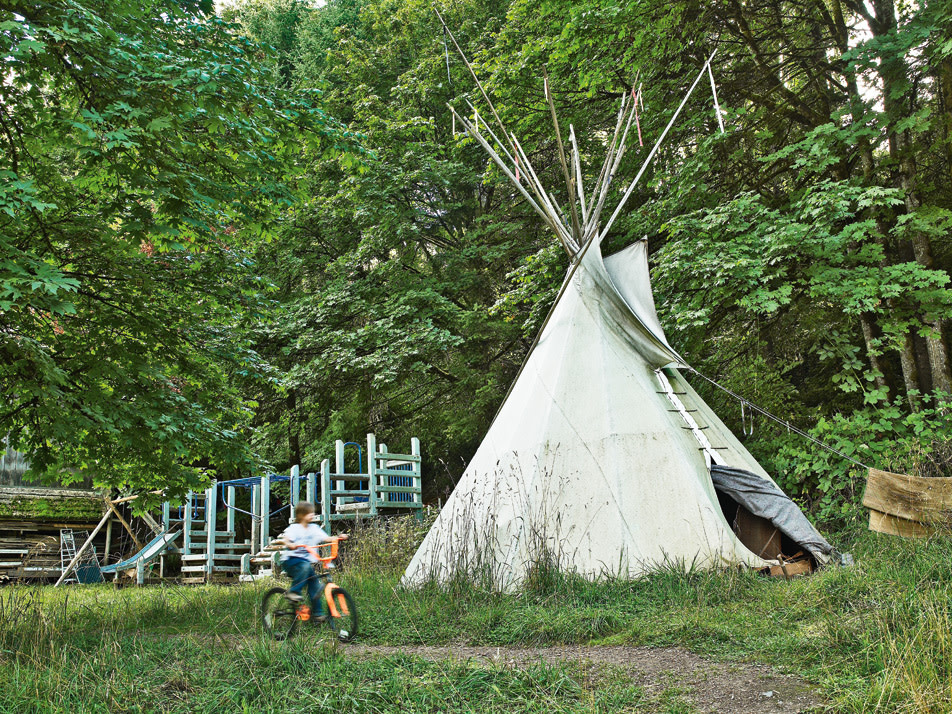
NO-CAR GARAGE A rustic tepee makes a perfect environmentally friendly abode for Cedar Moon resident Bernhard Bach.
Image: Stuart Mullenberg
But keeping Cedar Moon afloat means more than just writing checks. Space in the commune doesn’t become available often (the newest members have already been there a year), and when there is an opening, it sets into motion meetings, trial runs with potential lodgers, and a screening process that attempts to separate the folks who truly believe in the commune’s goals from those who just think not wearing deodorant for a few months would be “neat.” Compatibility is key, but so are things like keeping a workable ratio of males to females, kids to adults, and couples to singles. And then there’s the issue of sex.
“Living in small spaces with 20 people in their 20s and 30s who are basically awesome,” Bell says, cocking an eyebrow suggestively, “things come up. Some people here are involved in open relationships, others are monogamous. The sexual dynamic is really fascinating, but it means we have to be very open with our communication and accountability. Otherwise, having a community couple break up can be super-awkward.”
Perhaps worse, though, is the frustration that can manifest when your space is limited to the walls of your bedroom. Except for the four separate living quarters in the secondary house, every other square inch of Cedar Moon is communal property. “It’s hard sometimes,” Hogan says. “Everybody is on top of each other, and sometimes you just want to be left alone. Here, that’s not really an option. I’ve been known to hand my kids off to another member of the community and disappear into the park for a while.”
Later in the evening, as the last of the summer’s 100-plus-degree days mercifully cools to a dull simmer, I’m sitting in the long grass with Bell. Goats meander around us, while 4-year-old Ember picks at salted sesame-seed crackers.
“Some people use the term reindigenize to describe us, but I don’t know,” Bell says, slipping the walking boot off and massaging her aching toes. “I think as a community we’re just figuring out where to go as people who were raised in a modern culture, but who want to get back to a different way of life. I want to help build a sustainable culture that will last for generations.”
Perhaps sensing her mom’s point, Ember wriggles out of her clothes. Earlier in the day, she completely blew the minds of a group of middle schoolers when she nonchalantly squatted to pee in the woods during a hike. Now, with no outsiders around, she’s going full-out nature child. Buck naked, she takes a strafing run at the goats, then throws herself over the seat of a nearby swing set. As the sun begins to droop beneath the surrounding cedars, her tiny white fanny arcs back and forth in the air.
Thirty minutes later, I’m behind the wheel staring at a flashing yellow sign hanging over Interstate 5. It’s warning me of a smog advisory. In Portland? It sounds like a mistake, but a quick glance to the right confirms the alert: Mount Hood is barely visible through a thick gray haze, and Mount St. Helens is just a rumor. The only thing crystal clear is the line of taillights leading back toward downtown.
Suddenly, the horror of the composting toilet doesn’t seem so bad.


